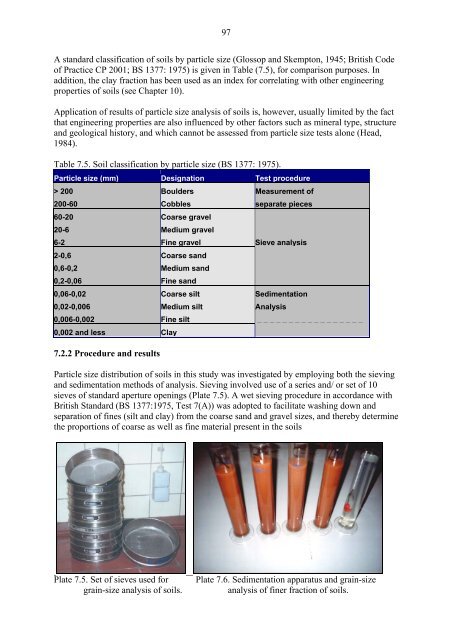an engineering geological characterisation of tropical clays - GBV
an engineering geological characterisation of tropical clays - GBV
an engineering geological characterisation of tropical clays - GBV
Create successful ePaper yourself
Turn your PDF publications into a flip-book with our unique Google optimized e-Paper software.
97<br />
A st<strong>an</strong>dard classification <strong>of</strong> soils by particle size (Glossop <strong>an</strong>d Skempton, 1945; British Code<br />
<strong>of</strong> Practice CP 2001; BS 1377: 1975) is given in Table (7.5), for comparison purposes. In<br />
addition, the clay fraction has been used as <strong>an</strong> index for correlating with other <strong>engineering</strong><br />
properties <strong>of</strong> soils (see Chapter 10).<br />
Application <strong>of</strong> results <strong>of</strong> particle size <strong>an</strong>alysis <strong>of</strong> soils is, however, usually limited by the fact<br />
that <strong>engineering</strong> properties are also influenced by other factors such as mineral type, structure<br />
<strong>an</strong>d <strong>geological</strong> history, <strong>an</strong>d which c<strong>an</strong>not be assessed from particle size tests alone (Head,<br />
1984).<br />
Table 7.5. Soil classification by particle size (BS 1377: 1975).<br />
Particle size (mm) Designation Test procedure<br />
> 200 Boulders Measurement <strong>of</strong><br />
200-60 Cobbles separate pieces<br />
60-20 Coarse gravel<br />
20-6 Medium gravel<br />
6-2 Fine gravel Sieve <strong>an</strong>alysis<br />
2-0,6 Coarse s<strong>an</strong>d<br />
0,6-0,2 Medium s<strong>an</strong>d<br />
0,2-0,06 Fine s<strong>an</strong>d<br />
0,06-0,02 Coarse silt Sedimentation<br />
0,02-0,006 Medium silt Analysis<br />
0,006-0,002 Fine silt _ _ _ _ _ _ _ _ _ _ _ _ _ _ _ _ _<br />
0,002 <strong>an</strong>d less Clay<br />
7.2.2 Procedure <strong>an</strong>d results<br />
Particle size distribution <strong>of</strong> soils in this study was investigated by employing both the sieving<br />
<strong>an</strong>d sedimentation methods <strong>of</strong> <strong>an</strong>alysis. Sieving involved use <strong>of</strong> a series <strong>an</strong>d/ or set <strong>of</strong> 10<br />
sieves <strong>of</strong> st<strong>an</strong>dard aperture openings (Plate 7.5). A wet sieving procedure in accord<strong>an</strong>ce with<br />
British St<strong>an</strong>dard (BS 1377:1975, Test 7(A)) was adopted to facilitate washing down <strong>an</strong>d<br />
separation <strong>of</strong> fines (silt <strong>an</strong>d clay) from the coarse s<strong>an</strong>d <strong>an</strong>d gravel sizes, <strong>an</strong>d thereby determine<br />
the proportions <strong>of</strong> coarse as well as fine material present in the soils<br />
Plate 7.5. Set <strong>of</strong> sieves used for<br />
grain-size <strong>an</strong>alysis <strong>of</strong> soils.<br />
Plate 7.6. Sedimentation apparatus <strong>an</strong>d grain-size<br />
<strong>an</strong>alysis <strong>of</strong> finer fraction <strong>of</strong> soils.
















